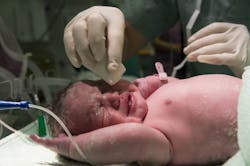A four-year effort has reduced the rate of cesarean sections for low-risk, first-time mothers in California, according to a study led by researchers at the Stanford University School of Medicine and the California Maternal Quality Care Collaborative, according to a news release from the university.
The study is published in the Journal of the American Medical Association.
Several coordinated initiatives to reduce C-sections took place across the state during the 2015-2019 study period, including messaging to all hospitals from state agencies and health plans, annual public reporting of hospitals’ C-section rates, and a quality improvement program targeting hospitals with the highest rates.
The study examined the collective effect of these projects, which have led California to become the first state in the country to achieve a sustained reduction in C-section rates.
In 2014, before the study began, 26% of first-time California mothers with low-risk pregnancies underwent C-sections, a rate equal to the current national average. By 2019, the statewide effort had lowered California’s C-section rate to 22.8%, bringing it below a public health target of 23.9% set by the Centers for Disease Control and Prevention in its Healthy People 2020 goals.
“It’s a big change from the U.S. average, and our collective efforts have not only significantly lowered the average rate for the state but also narrowed the variation between hospitals in California,” said Elliott Main, MD, Clinical Professor of Obstetrics and Gynecology at Stanford Medicine. “This is great news for California women, especially because we have preserved and even improved on babies’ outcomes at the same time.”
The research focused on C-section rates for first-time mothers with low-risk deliveries, known as NTSV, or nulliparous term singleton vertex births. This means the mother was having her first child, the pregnancy was at or near its due date, the baby was not a twin or other multiple, and the baby was positioned head-down before delivery.
Throughout the study period, annual C-section rates for NTSV births at all 238 hospitals in California were released to the public. Each year, hospitals that achieved the C-section rates of 23.9% or lower received recognition from the California Health and Human Services Agency. Some health plans also began providing their hospitals with incentives to lower their C-section rates.
Hospitals with C-section rates above 23.9% were invited to participate in an intense, 18-month, quality-improvement initiative aimed at lowering their rates; of 149 hospitals with rates higher than 23.9%, 91 participated. This initiative was led by the California Maternal Quality Care Collaborative, a statewide project to improve maternity care with headquarters at Stanford University.

